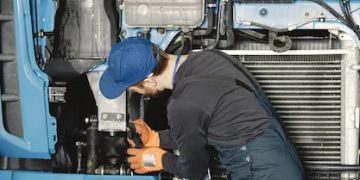The automotive repair industry in India plays a crucial role in maintaining and servicing the vast number of vehicles on the country’s roads. It is an industry that encompasses a wide range of services, from routine maintenance to complex repairs, and it serves as a critical link in ensuring the safety and reliability of vehicles. However, like any industry that deals with machinery and tools, the automotive repair sector also presents its own set of safety challenges. However, the industry is also associated with several health and safety hazards that can cause injuries and illnesses to workers. Therefore, it is essential to implement safety practices to ensure the well-being of workers and customers. In this article, we will explore the safety practices in the automotive repair industry in India, highlighting the importance of safety protocols, the existing challenges, and potential solutions for a safer working environment.
Common Hazards in the Automotive Repair Industry
Before discussing safety practices, it is essential to understand the common hazards in the automotive repair industry. According to a study conducted in South India, the most common health problems among auto service industry workers were musculoskeletal disorders, respiratory problems, and skin diseases. The study also found that workers were exposed to noise, dust, and chemicals, which can cause hearing loss, lung damage, and skin irritation.
The Government of India has established regulations to ensure the safety of vehicles on Indian roads. The Ministry of Road Transport and Highway constituted a permanent Automotive Industry Standards Committee (AISC) to expedite the publication of standards and development of test facilities in parallel with the work of the preparation of the standards. The development of improved safety critical parts could be undertaken only after the publication of the standard and commissioning of test facilities.
When vehicles undergo the process of washing, it inadvertently introduces a range of chemicals and harmful substances into the environment, underscoring the significance of mitigating this impact. To address this issue, it is imperative to implement special safety measures while cleaning vehicles. These measures encompass the careful selection of cleaning products and the use of proper disposal methods to limit the release of pollutants.
The consequences of failing to manage these pollutants are twofold. Firstly, the residual substances washed off cars often find their way into drainage systems. Once there, these substances can be detrimental to the living organisms inhabiting these aquatic environments. Chemicals, such as detergents and solvents, can disturb the delicate ecological balance, posing risks to aquatic life and ecosystem health. Over time, these contaminants can accumulate and be transported downstream through the drainage systems, ultimately reaching rivers. This influx of pollutants into rivers exacerbates environmental harm, negatively impacting water quality and the biodiversity of the affected water bodies.
Also, there is a concerning practice involving used oil extracted from vehicles. This used oil is illicitly repackaged and subsequently sold in a shadow market, with small roadside mechanics often being the primary users of this substandard lubricant. This practice not only raises significant concerns but also comes with far-reaching consequences.
Using this repackaged used oil in vehicle maintenance elevates the risk of damage to crucial vehicle components. The low quality and impurities in such oil can lead to accelerated wear and tear, potentially shortening the lifespan of vehicles and impacting their overall performance. In addition to the harm inflicted on individual vehicles, the use of this substandard oil contributes to pollution. It releases harmful emissions and contaminants into the environment, adding to the overall burden of air and environmental pollution in India.
Given these dire consequences, it is not enough to simply acknowledge the issue; comprehensive measures must be taken to curb the illicit market for used vehicle oil. Authorities should enforce stringent regulations to detect and prevent the repackaging and sale of substandard oil. Additionally, educating consumers and promoting the use of certified and environmentally friendly lubricants is vital to mitigate pollution, safeguard vehicle performance, and uphold environmental standards.
Safety Practices in the Automotive Repair Industry
The automotive repair industry in India is vast, with thousands of small and large repair shops scattered across the country. It encompasses everything from routine oil changes and brake repairs to more complex tasks like engine overhauls and accident repairs. With the increasing number of vehicles on Indian roads, the demand for automotive repair services is steadily rising. However, this growth also brings new challenges and safety concerns.
To prevent injuries and illnesses, it is essential to implement safety practices in the automotive repair industry. The following are some safety practices that can be implemented in the industry:
Protective Clothing: A major part of staying safe in an auto repair shop is to wear the right protective clothing. In addition to choosing a protective uniform that consists of fire and chemical-resistant clothing, the following uniform elements shouldn’t be left out:
- Gloves – Handling engines and car parts that become extremely hot is a safety hazard for automotive technicians. Engines and car parts are also very dirty, and even small cuts could easily become infected if not kept clear of dirt and debris.
- Goggles – As mechanics or auto technicians, employees are up close and personal with many dangerous car parts and chemicals. Goggles protect the eyes from flying debris and chemicals.
- Respirators – Workers should wear respirators to protect their lungs from dust, fumes, and other airborne hazards.
- Earplugs – Workers should wear earplugs to protect their ears from loud noise.
Occupational Health and Safety: Vehicle repair workers need to be educated on the dangers associated with their work and the best practices to be adopted to curb or forestall these risks. A study was conducted on occupational health and safety practices among vehicle repair artisans in an urban area in Ghana. The study found that workers in the auto garages were aware that they are exposed to different occupational safety and health hazards in the categories of physical, biological, ergonomic, and psychological hazards. Hazards arising from auto garages could impair the health and well-being of the workers; therefore, it is necessary to anticipate, recognise, evaluate, and control such hazards.
Training and Education
Training and education are essential for safety practices in the automotive repair industry in India. The industry involves working with heavy machinery, chemicals, and electrical equipment, which can pose significant risks to workers’ safety. Safety measures help protect employees from accidental injuries to themselves, their co-workers, customers, and the vehicles they are repairing. Workers should be educated on the right procedures to follow in case of common auto shop safety risks, such as fires, electrical issues, and chemical spills. Regular retraining of new and existing employees in the right steps to take in case of such safety risks can minimise the damage they cause when they happen.
A study conducted in South India found that auto service industry workers had a higher prevalence of respiratory symptoms, musculoskeletal disorders, and skin problems compared to the general population. Proper training and education can help workers avoid exposure to harmful chemicals and reduce the risk of developing occupational illnesses. Workers who are trained in safety practices are more likely to be productive and efficient in their work. They are less likely to be injured on the job, which can lead to fewer absences and less downtime.
Safe Work Practices
Safe work practices are essential in the automotive repair industry to prevent injuries and illnesses. The following are some safe work practices that can be implemented in the industry:
- Housekeeping: Workers should keep the workplace clean and free of clutter to prevent slips, trips, and falls.
- Tool Safety: Workers should use tools safely and follow the manufacturer’s instructions.
- Lifting Techniques: Workers should use proper lifting techniques to prevent back injuries.
- Chemical Handling: Workers should handle chemicals safely and follow the manufacturer’s instructions.
- Electrical Safety: Workers should follow electrical safety procedures and avoid working on electrical equipment when it is energised.
Emergency Preparedness
Emergency preparedness is essential in the automotive repair industry to ensure that workers know how to respond to emergencies. The following are some emergency preparedness measures that can be implemented in the industry:
- First Aid: Workers should be trained in first aid and know how to respond to common injuries such as cuts, burns, and eye injuries.
- Fire Extinguishers: Fire extinguishers should be available in the workplace, and workers should be trained on how to use them.
- Emergency Exits: Emergency exits should be clearly marked, and workers should know how to evacuate the workplace in case of an emergency.
ASDC’s Focus on Safety in Automotive Repair Training
Automotive Skills Development Council (ASDC) has made significant strides in promoting safety within the automotive repair sector in India. A key aspect of their efforts is the development of 31 specific job roles related to the service segment, with a primary focus on automotive repair. Within these roles, ASDC has integrated robust safety training to ensure that technicians and professionals in the field are well-equipped to prioritise safety in their work.
ASDC’s commitment to safety is evident through its training programmes, where it instils best practices for safety and common hazards associated with automotive repair. These programmes emphasise the importance of creating a safe working environment, safeguarding technicians from potential risks and hazards, and enhancing overall operational safety.
By incorporating safety principles into its curriculum and training, ASDC not only produces skilled and proficient technicians but also ensures that they are conscious of safety standards and adhere to them. This approach contributes to a safer and more professional automotive repair industry in India, benefitting both the workforce and customers. Moreover, ASDC’s holistic approach underscores the organisation’s commitment to promoting a culture of safety and excellence in the automotive service segment, furthering the industry’s overall development and reputation.
Conclusion
In conclusion, safety practices are essential in the automotive repair industry in India to prevent injuries and illnesses to workers and customers. Personal protective equipment, training and education, safe work practices, and emergency preparedness are some of the safety practices that can be implemented in the industry. By implementing these safety practices, the automotive repair industry in India can provide a safe and healthy workplace for workers and customers.



























































